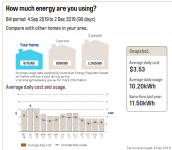The onboard computer shut down a certain new class of train, when the frequency fell below 50Hz, in order to protect the electronics. The actual power outage did not last long, but the software in some of the trains had not been updated to allow a restart. Technicians had to travel to those trains simply in order to update the software!Was embarassing as a load of electric trains wouldn't restart without a technician (discussed on here somewhere).
...Does the average home get by on 1/2 kW?
I quick-figure average 1.2KW here. This includes electric hot water, electric clothes dryer, and a toot of spot electric heat.
We actually could have done gas fired water and dryer. Matter of timing and largely cost of a gas-fitter we can trust. (I trust my big wire jobs.)
In parts of Massachusetts they are beginning to ban carbon-fuel installations if there is an alternative. Which means the coal (extinct), oil, and gas fires will be migrated to electricity in new buildings and eventually renovations. To get this to happen in a state which dammed all its hydro centuries ago, Mass wants to run an extension cord to Quebec Hydro, through Maine. Politics aside, that's a long wire.
Solar panels are a bit closer to home.
There is a 30 acre site about a mile away.
I was surprised to see the number of solar farms visible on the English side from the Eurostar we used to travel from Gare du Nord in France to St Pancras. Given your lack of sun compared to here, you put us to shame in that regard!
When we are talking 1.2KW I'm assuming that is per hour? ie average consumption for a day would be 28.8KWH?
Our usage is below, average and normally between about 5 and 14KWH / day. This summer the peak usage was 52KWH for one day!
We have solar, but it only outputs about 700W peak. On a good sunny day it might make around 3KWH so figures will be offset by that (little yellow bits on bottom of graph are excess put back to the grid).
First pic shows usage from the last bill (note we are a 4 person household and we have gas hot water and gas stove, average daily usage ~48MJ). Second pic shows daily usage this billing period, and third is daily usage from the previous billing period.
Tony.
Our usage is below, average and normally between about 5 and 14KWH / day. This summer the peak usage was 52KWH for one day!
We have solar, but it only outputs about 700W peak. On a good sunny day it might make around 3KWH so figures will be offset by that (little yellow bits on bottom of graph are excess put back to the grid).
First pic shows usage from the last bill (note we are a 4 person household and we have gas hot water and gas stove, average daily usage ~48MJ). Second pic shows daily usage this billing period, and third is daily usage from the previous billing period.
Tony.
Attachments
Last edited:
Although I'd expect the blade system to be of the constant velocity type, their size would have to be based on producing full output in lower wind conditions, but with a limited compromise.. don't make them produce full output during especially low winds as they would have to be made too large. I'm not sure they would produce the 7MW each at all times.it only outputs about 700W peak. On a good sunny day it might make around 3KWH
Great windfarm. I really wish we would invest in tidal power though, unlike solar and wind it needs no backup, it's always generating.
You are very lucky then - I don't think that's typical at all!
Currently showing 7.1%... 🙂
Great site though - I use it lot.
You can check grid health by measuring your own mains frequency. That bit is very well maintained! And has to be!
Wind very low at the moment, a calm day. The weekend may see some wind farms shut down, given the high winds expected!
Plan in the UK is to stop all gas use...
local failures almost unknown ( not had one interruption in 15 yrs at my location).
You are very lucky then - I don't think that's typical at all!
Realtime (last 10-minute summary derived from UK National Grid data export) available as convenient graphs here:
G. B. National Grid status
All UK coal-fired power stations will be gone by 2025; that's down from a solid 40-50% av contribution in under 15 years; as it is, today the max coal-fired output possible is just under c. 6% of peak demand.
Currently showing 7.1%... 🙂
Great site though - I use it lot.
You can check grid health by measuring your own mains frequency. That bit is very well maintained! And has to be!
Wind very low at the moment, a calm day. The weekend may see some wind farms shut down, given the high winds expected!
We actually could have done gas fired water and dryer. Matter of timing and largely cost of a gas-fitter we can trust. (I trust my big wire jobs.)
Plan in the UK is to stop all gas use...
Recent research suggests that cats are less of a problem than thought and generally only catch old or sick birds as the healthy ones are too quick for them. ?
We saw this at an exhibition once .. Yep they were Demo cats.
If you see a turbine stopped amongst others in a wind farm. It is because their mechanisms overheat after a while , so they are cooling off. Genuine fact fram a technician who works
within the industry.
We saw this at an exhibition once .. Yep they were Demo cats.
If you see a turbine stopped amongst others in a wind farm. It is because their mechanisms overheat after a while , so they are cooling off. Genuine fact fram a technician who works
within the industry.
.. a few years ago, one of the UK PES earned more from their windfarms in payments from the grid to shut down than in generation.... Win / win!
When we are talking 1.2KW I'm assuming that is per hour? ....
Obviously you know a KW from a KHh, so I'm not sure what you are asking. Here, you read the bumph on the hydro my_account website and the bill:
Attachments
Thanks PRR, yes sorry I probably didn't word very well. as KW is an instantaneous value I wasn't quite sure how to interpret it 🙂
I was thinking either an average (over the entire day) or a peak value, average seemed the more likely.
Tony.
I was thinking either an average (over the entire day) or a peak value, average seemed the more likely.
Tony.
My *monthly* bill, a PLUS charge ignored, divided by a remembered cents/KWH, divided by hours per month.
It is also an *average* of what I see when I walk past my own instantaneous power meters. I get 240V and take from 1.2A to 50A, but "5" is a very common zone.
PLUS is insurance on 2 poles (500 feet) self-owned power wire. A $10/month gamble. So far I've paid around $700 over the years, and had one ~~$700 broken-wire (tree fall) repaired without the least hassle. As I have 80 foot Spruce grown so close together they can't fall without hitting each other (or the wire), it's conservative gambling.
It is also an *average* of what I see when I walk past my own instantaneous power meters. I get 240V and take from 1.2A to 50A, but "5" is a very common zone.
PLUS is insurance on 2 poles (500 feet) self-owned power wire. A $10/month gamble. So far I've paid around $700 over the years, and had one ~~$700 broken-wire (tree fall) repaired without the least hassle. As I have 80 foot Spruce grown so close together they can't fall without hitting each other (or the wire), it's conservative gambling.
Your 240V comment got me to do a google search. I didn't realize that coming into the house in the US was 240V (2 X 120V split) and that selected appliances run 240 and everything else 120V. Learn something every day! 🙂
Tony.
Tony.
> I didn't realize that coming into the house in the US was 240V (2 X 120V split)
People in the UK (and kin) have some strange ideas about US power.
The key issue was probably Electric Ranges (cookers). It's good load for the electric company. In a time before wide use of gas, or foul coal-gas, electric was clean. But the size of conductors at 110V was expensive. You could 2X the copper in each wire, ouch. Or you could bring in a 3rd wire at opposite phase and cost is nearer 1.5X. Also (and you might not have this) you can get more combinations of medium and low by switching a 220V burner to 110V tap. Two elements per burner of 1600 and 1000 watts nominal can give 2600 1600 1400 1000 650 400 250 seven heats. With no triac or thermo-relay.
We have 240V. We just don't run it to minor loads. Tommy found fewer dead workers around <100V machines than >100V machines, we electrified before good insulation, we respect his wisdom (but fudge it over 125V).
Yes, our tea-kettles are 120V <15A 1500 Watts, and boil slower than yours. No matter, most of us use non-boiling Mr Coffee (or K-cup) type coffee machines with timers.
People in the UK (and kin) have some strange ideas about US power.
The key issue was probably Electric Ranges (cookers). It's good load for the electric company. In a time before wide use of gas, or foul coal-gas, electric was clean. But the size of conductors at 110V was expensive. You could 2X the copper in each wire, ouch. Or you could bring in a 3rd wire at opposite phase and cost is nearer 1.5X. Also (and you might not have this) you can get more combinations of medium and low by switching a 220V burner to 110V tap. Two elements per burner of 1600 and 1000 watts nominal can give 2600 1600 1400 1000 650 400 250 seven heats. With no triac or thermo-relay.
We have 240V. We just don't run it to minor loads. Tommy found fewer dead workers around <100V machines than >100V machines, we electrified before good insulation, we respect his wisdom (but fudge it over 125V).
Yes, our tea-kettles are 120V <15A 1500 Watts, and boil slower than yours. No matter, most of us use non-boiling Mr Coffee (or K-cup) type coffee machines with timers.
Last edited:
Thanks, yes all we know is people with US appliances needing step down transformers to operate them here. Never occured to me that what came from the pole was anything other than 110V. Never really thought about the fact that an Oven would require 30A wiring and breaker!! Even on 240V ovens (and I guess electric cooktops) here run 15A, standard outlets are 10A.
Tony.
Tony.
1.2kW each
..and can they even maintain 7MW on average
Does the average home get by on 1/2 kW?
I always raise a smile when I see this kind of headline... 'will power xyz number of homes'.
Many years ago we shared a site with one of the UK's regional electricity companies and I was told that new housing developments are based on a capacity of 1.5kW as an average per household.
We are all electric (no gas) so lets see...
Two 3.4kW storage heaters that take in 24kW total each overnight. Two similar 2.55kWh heaters, a 3kWh immersion heater that is on from 5:30AM to 7:AM, a couple of oil filled 1kWh radiators. So a possible load of just short of 17kW. Switch the kettle on and that's another 3kW.
So lets say 20 kW possible maximum loading (the supply is rated at 100 amp single phase).
The 174 7MW spinners would power just over 50,000 such homes.
...is nearly complete - can power 1 million homes. I read "the blades cover an area bigger than the London Eye observation wheel as they turn. Just a single rotation of one of the turbines can power the average home for an entire day"
.
What they haven't thought is if all these wind farms are going to slow down the rotation of the earth?
If the earth slows down too much the magnetic field will collapse and the suns particles will get through and kill us all.
If the earth stops spinning one side will cook while the other freezes over.
- Home
- Member Areas
- The Lounge
- World's largest offshore wind farm





